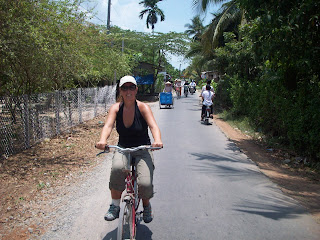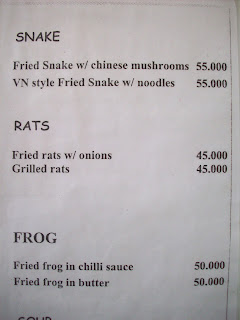

Travel from Nha Trang to Hoi An involved taking a 11 hour overnight sleeper bus. When we arrived in Hoi An we stayed for 10 minutes and then got back on the bus.... Its not that Hoi An is a bad place (we don't think), its just that we didn't really have anything planned to do there and we didn't see much of interest on the journey in. So when we found out that the same coach would be leaving in 10 minutes time heading northwards to Hue, we jumped back on. We were tired and smelly anyway from one coach journey so doing another was not going to matter lol...We arrived in Hue early and just in time for a very heavy downpour of rain. Having declined the offer of staying at hotel offered by the bus company, we checked into another nearby hotel. We found a few decent restaurants nearby, but food in Vietnam is still very 'hit and miss' in our experience. Most places serve very basic rice, meat and veg dishes or Pho which are not bad sometimes but they are often lacking in the taste department. Some restaurants do have a varied menu with some taste involved in the dishes, but you have to choose carefully...


The following day when decided to take a city tour, by boat and coach. We started at 8am and traveled along the perfume river (no it doesn't smell of chanel no 5!!!) to nearby Thien Mu pagoda. Which was fairly nice. After that, and by far the best bit of the tour was to a Vietnamese kung fu display of Vo Kinh. 8 people took it in turns to entertain us with some weapons displays and one on one attacks. It was very impressive, nothing at all like the 4 years of karate that I did..... We then boarded the boat again and after that it all went downhill a bit. We had some lunch on the now very slow moving boat and visited 3 tombs and a temple. We went in the first tomb (Minh Mang tomb) which was fully completed in 1843. Minh Mang's tomb consists of 40 constructions (palaces, temples, pavilions, etc.) designed on a symmetric axis running from Dai Hong gate to the foot of La Thanh (Surrounding Wall) behind the Emperor's tomb. There grounds contain a nice lake and beautiful forests and gardens. It was all very peaceful and tranquil, but when you've seen one temple, you've seen em all ;-) So we didn't go in the next two tombs and nor did a lot of other people in the group.The last thing we saw (which was good) was a display by local village people making incense sticks and conical hats by hand. Then it was back to the hotel at 4:30pm. Tour over......




We then decided that we should go on the "DMZ tour" the following day. Starting at 6am and lasting for 12 hours and seeing us travel over 200 kilometres, we certainly were glutton for punishment. And now for some history:The Vietnamese Demilitarized Zone was established as a dividing line between North and South Vietnam as a result of the First Indochina War.During the Second Indochina War (popularly known as the Vietnam War), it became important as the battleground demarcation separating North Vietnamese territory from South Vietnamese territory.The Vietnamese Demilitarized Zone ran from east-west near the center of present-day Vietnam (spanning more than a hundred kilometers) and was a couple of kilometers wide. It ran along the Ben Hai river for much of its length, and an island nearby was controlled by North Vietnamese forces during the Vietnam War. Although it was nominally described as being at "the 17th parallel," almost all of the zone lies to the south of the parallel, with only a small portion of the zone near the eastern shore actually including the parallel.It was a little different from the Cu Chi tunnel tour that we did in that the Vinh Moc tunnels, housed an entire village that lived there for two and a half years. 17 were also babies were born in the tunnels during that time. The tunnels that we entered were bigger, longer and deeper than Cu Chi tunnels and we went down to a depth of about 25 metres to see the deepest tunnels.


The following day when decided to take a city tour, by boat and coach. We started at 8am and traveled along the perfume river (no it doesn't smell of chanel no 5!!!) to nearby Thien Mu pagoda. Which was fairly nice. After that, and by far the best bit of the tour was to a Vietnamese kung fu display of Vo Kinh. 8 people took it in turns to entertain us with some weapons displays and one on one attacks. It was very impressive, nothing at all like the 4 years of karate that I did..... We then boarded the boat again and after that it all went downhill a bit. We had some lunch on the now very slow moving boat and visited 3 tombs and a temple. We went in the first tomb (Minh Mang tomb) which was fully completed in 1843. Minh Mang's tomb consists of 40 constructions (palaces, temples, pavilions, etc.) designed on a symmetric axis running from Dai Hong gate to the foot of La Thanh (Surrounding Wall) behind the Emperor's tomb. There grounds contain a nice lake and beautiful forests and gardens. It was all very peaceful and tranquil, but when you've seen one temple, you've seen em all ;-) So we didn't go in the next two tombs and nor did a lot of other people in the group.The last thing we saw (which was good) was a display by local village people making incense sticks and conical hats by hand. Then it was back to the hotel at 4:30pm. Tour over......




We then decided that we should go on the "DMZ tour" the following day. Starting at 6am and lasting for 12 hours and seeing us travel over 200 kilometres, we certainly were glutton for punishment. And now for some history:The Vietnamese Demilitarized Zone was established as a dividing line between North and South Vietnam as a result of the First Indochina War.During the Second Indochina War (popularly known as the Vietnam War), it became important as the battleground demarcation separating North Vietnamese territory from South Vietnamese territory.The Vietnamese Demilitarized Zone ran from east-west near the center of present-day Vietnam (spanning more than a hundred kilometers) and was a couple of kilometers wide. It ran along the Ben Hai river for much of its length, and an island nearby was controlled by North Vietnamese forces during the Vietnam War. Although it was nominally described as being at "the 17th parallel," almost all of the zone lies to the south of the parallel, with only a small portion of the zone near the eastern shore actually including the parallel.It was a little different from the Cu Chi tunnel tour that we did in that the Vinh Moc tunnels, housed an entire village that lived there for two and a half years. 17 were also babies were born in the tunnels during that time. The tunnels that we entered were bigger, longer and deeper than Cu Chi tunnels and we went down to a depth of about 25 metres to see the deepest tunnels.
We also stopped along some other significant points of interest along the way, but there wasn't really much to see. They were merely places of extreme importance during the "American war". We also stopped at the sight of the former Khe Sanh American combat base which was sat atop a plateau and was the site of another famous battle. Now, there are a few helicopters left on the site , a tank, some shells, some bunkers and a museum. There is also work underway to reproduce the former airstrip. We arrived back in our hotel at 7pm..Tired!! With numb bums......










































